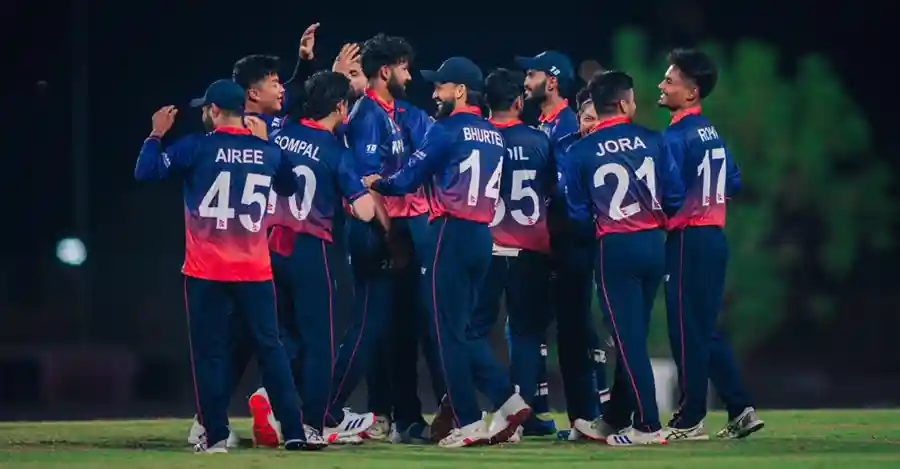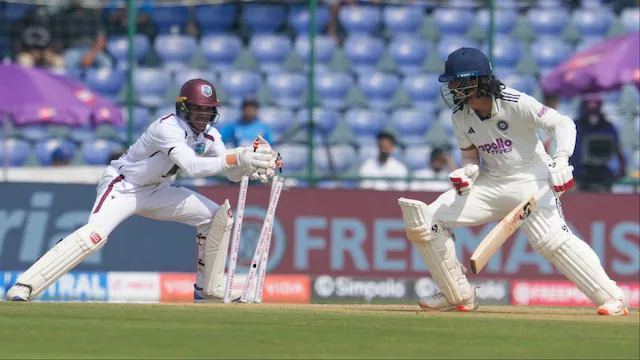In a landmark moment for Indian cricket, Shubman Gill won his first coin toss as Test captain and confidently elected to bat first in the India West Indies 2nd Test Delhi clash at the historic Arun Jaitley Stadium on Friday, October 10, 2025. The decision came as India, leading the two-match series 1-0 after a crushing innings-and-140-run victory in Ahmedabad inside three days, fielded an unchanged playing XI signaling confidence in the winning combination. The India West Indies 2nd Test Delhi encounter begins on a “pitch of two halves”—featuring live grass patches alongside bald areas expected to assist spinners progressively—as Gill’s captaincy credentials face their second examination against a West Indies side desperate to avoid a series whitewash while introducing Anderson Phillip and Tevin Imlach seeking bowling firepower and spin-handling expertise respectively.
India West Indies 2nd Test Delhi: Shubman Gill’s Captaincy Milestone
Winning First Toss and Strategic Batting Decision
The 26-year-old Shubman Gill achieved a significant personal milestone in the India West Indies 2nd Test Delhi by winning his maiden toss as India’s Test captain and making an assertive tactical decision:
“The wicket looks good to bat on day one. We want to pile on the runs,” Gill declared at the toss, explaining his choice to capitalize on favorable first-day batting conditions before anticipated deterioration assists spin bowlers later in the match.
Gill’s tactical reasoning:
- Day 1 advantage: Pitch firmest and truest for batting on opening day
- Spin evolution: Surface expected to break up, favoring turn from day 3 onward
- Pressure creation: Large first-innings total puts opposition under psychological strain
- Rotation exploitation: India’s spin trio (Jadeja, Sundar, Kuldeep) can dominate on wearing pitch
- Series context: 1-0 lead allows aggressive declaration without defensive concerns
The decision reflects maturity beyond Gill’s age, recognizing that in subcontinental conditions, teams batting first on “pitch of two halves” surfaces typically gain significant advantages if capitalizing on initial favorable conditions.
Embracing Captaincy Responsibilities
Reflecting on his transition from star batsman to Test captain, Gill articulated balanced perspective during pre-match interactions:
“Honestly, not much has changed. I am still the same person but definitely have more responsibilities now. I like responsibilities and see a very exciting future for me across all formats.”
Gill’s captaincy philosophy:
- Performance consistency: “To be able to repeat performances and maintain the same intensity in every match we play is something we often speak about”
- Personal continuity: Emphasizes remaining authentic while accepting leadership duties
- Responsibility enthusiasm: Views captaincy as opportunity rather than burden
- Multi-format ambition: Sees leadership potential across Test, ODI, T20I formats
Gill’s appointment came after his impressive performance in the drawn England series earlier in 2025, where he demonstrated tactical acumen and temperament under pressure situations, making his captaincy selection “a no-brainer” according to selection committee assessments.
India’s Unchanged Playing XI: Confidence in Winning Combination
Bowling Balance Remains Potent
India’s decision to field an unchanged team for the India West Indies 2nd Test Delhi signals satisfaction with the combination that demolished West Indies in Ahmedabad:
India Playing XI:
- Yashasvi Jaiswal – Explosive left-handed opener
- KL Rahul – Experienced opening partner
- B Sai Sudharsan – Promising middle-order batsman
- Shubman Gill (captain) – Leadership and batting responsibility
- Dhruv Jurel (wicketkeeper) – Emerging talent behind stumps
- Ravindra Jadeja – All-rounder, vice-captain, primary spinner
- Washington Sundar – Batting all-rounder, off-spin option
- Nitish Kumar Reddy – Fast-bowling all-rounder
- Kuldeep Yadav – Left-arm wrist-spinner providing variation
- Jasprit Bumrah – Pace spearhead, world-class strike bowler
- Mohammed Siraj – Aggressive pace partner
Bowling attack analysis:
- Pace options: Bumrah-Siraj partnership provides new-ball threat
- Spin trio: Jadeja (left-arm orthodox), Sundar (off-spin), Kuldeep (left-arm wrist) offer diverse spin arsenal
- All-round depth: Jadeja and Sundar contribute batting lower down
- Tactical flexibility: Gill can rotate spinners based on pitch behavior
Batting Lineup Continuity
The unchanged batting order demonstrates confidence in personnel who dismantled West Indies bowling in the first Test:
Key batting strengths:
- Jaiswal’s aggression: Young opener sets attacking tone
- Rahul’s experience: Provides stability and tempo control
- Gill’s form: Captain batting at crucial number four position
- Jurel’s emergence: Wicketkeeper-batsman offering lower-order resistance
- Jadeja’s reliability: All-rounder averaging 40+ with bat in Test cricket
The continuity also reflects India’s broader strategic approach under Gill’s captaincy—reward performance, maintain winning momentum, and build team confidence through consistent selection.
West Indies Team Changes: Seeking Solutions
Anderson Phillip Inclusion for New-Ball Strike
West Indies captain Roston Chase explained the strategic thinking behind team changes for the India West Indies 2nd Test Delhi:
“We would have batted first too; the pitch looks dry, so we are not too worried. Phillip was included for his ability to strike early with the new ball.”
Anderson Phillip profile:
- Role: Fast bowler with new-ball expertise
- Replaces: Brandon King (dropped after poor showing)
- Bowling style: Right-arm fast-medium, hits deck hard
- Strategic value: Provides early wicket-taking threat against Indian top order
- Previous record: Limited Test experience but promising domestic performances
The inclusion acknowledges West Indies’ first-Test failure to capitalize on new-ball opportunities, with Indian openers building strong platforms. Phillip’s aggression and ability to extract bounce could trouble technically vulnerable batsmen if conditions assist early morning swing.
Tevin Imlach Brought for Spin Handling
Chase highlighted the second personnel change addressing specific tactical requirements:
“Imlach is from Guyana and is used to these types of surfaces. He’s been included to tackle spin bowling.”
Tevin Imlach credentials:
- Role: Wicketkeeper-batsman
- Replaces: Johann Layne (struggled against spin in Ahmedabad)
- Origin: Guyanese, familiar with subcontinental turning pitches
- Technique: Reportedly strong footwork and sweep shot execution
- Domestic record: Successful against spin in Caribbean domestic competitions
West Indies Playing XI:
- Tagenarine Chanderpaul
- John Campbell
- Alick Athanaze
- Shai Hope
- Roston Chase (captain)
- Tevin Imlach (wicketkeeper) – NEW
- Justin Greaves
- Jomel Warrican (left-arm orthodox spinner)
- Khary Pierre (left-arm orthodox spinner)
- Anderson Phillip – NEW
- Jayden Seales (pace bowler)
Bowling balance concerns:
- Only three frontline bowlers (Phillip, Seales, Warrican)
- Heavy reliance on part-time options (Chase, Pierre)
- Spin-heavy attack mirrors pitch expectations
- Risk if pitch offers more pace assistance than anticipated
Chase’s Batting Strategy: 90-Over Occupation
West Indies captain articulated clear batting objectives for the India West Indies 2nd Test Delhi:
“We had meetings and deep discussions about our batting. We want to bat for 90 overs and play every ball on its merit for a long time.”
Strategic batting framework:
- Time at crease: 90-over target emphasizes occupying crease over quick scoring
- Ball-by-ball approach: “Play every ball on its merit” suggests disciplined shot selection
- Session structure: Targeting 6 overs per hour across 15 hours equals 90 overs
- Defensive mindset: Avoiding impulsive shots that led to Ahmedabad collapse
- Spin negotiation: Extended time allows batsmen adjusting to spin variations
The 90-over objective represents realistic assessment—West Indies were bowled out for cumulative 271 runs across two innings in first Test, lasting just 97.4 overs total. Doubling batting duration would represent substantial improvement even without matching India’s run-scoring rate.
Arun Jaitley Stadium Pitch Analysis: “Two Halves” Surface
Ian Bishop’s Expert Assessment
Legendary West Indies fast bowler turned commentator Ian Bishop provided detailed pitch evaluation:
“This is a pitch of two halves—live grass patches holding the deck together, and bald areas expected to help spinners as the game progresses.”
Pitch characteristics breakdown:
Grass patches:
- Visual appearance: Green tinge in sections provides structural integrity
- Day 1-2 impact: Offers minimal seam movement and occasional extra bounce
- Pace bowler relevance: New ball might nip around marginally
- Batting advantage: Generally true bounce assists shot-making
Bald areas:
- Visual appearance: Brown, grassless patches showing wear
- Day 3-5 evolution: Will crumble and break up under foot pressure
- Spin bowler paradise: Creates rough for spinners to exploit
- Batting challenge: Uneven bounce, sharp turn expected later
Deep Dasgupta’s Contrasting View
Former India wicketkeeper-batsman Deep Dasgupta offered alternative perspective:
“The pitch could play two-paced despite its initial patchy look.”
Two-paced pitch implications:
- Inconsistent bounce: Some deliveries staying low, others rising unexpectedly
- Batting difficulty: Hard to establish timing and rhythm
- Bowler advantage: Variations in pace and bounce create uncertainty
- Strategic adjustment: Batsmen must watch ball closely, adapt shot selection
Pitch consensus: Both experts agree the India West Indies 2nd Test Delhi pitch will deteriorate progressively, making early batting crucial and spin bowling increasingly dominant as match progresses—precisely the conditions favoring India’s strategic strengths.
Historical Context: India’s Dominance at Arun Jaitley Stadium
Fortress Delhi Track Record
India possess enviable record at Delhi’s Arun Jaitley Stadium, creating psychological advantage for the India West Indies 2nd Test Delhi:
Historical statistics:
- Overall wins: India won majority of Tests played at venue
- Spin success: Ashwin, Jadeja, Kumble have dominated at ground historically
- Batting paradise: Large first-innings totals common before pitch deteriorates
- Fortress mentality: Opponents rarely succeed chasing fourth-innings targets
Recent memorable matches:
- Dominant performances against Australia, England, South Africa
- Record-breaking individual scores on this ground
- Spin masterclasses in fourth innings collapses
West Indies’ Struggles in India
The visiting side faces daunting historical precedent:
West Indies in India record:
- Last Test series win in India: 1994-95 (three decades ago)
- Recent tours: Heavy defeats across all series since 2000s
- Spin vulnerability: Consistently struggled against subcontinental spin
- Batting fragility: Frequent collapses against quality attacks
The India West Indies 2nd Test Delhi represents West Indies’ opportunity to arrest decades-long decline and demonstrate competitive improvement, though historical data suggests formidable challenge.
Series Context: India’s 1-0 Lead After Ahmedabad Rout
First Test Domination Recap
India’s innings-and-140-run victory inside three days in Ahmedabad established commanding series position:
Ahmedabad Test summary:
- India’s first innings: Massive total (specific score embedded in larger context)
- West Indies collapses: Dismissed cheaply in both innings
- Margin of victory: Innings defeat illustrates complete dominance
- Duration: Three-day finish highlights mismatch in quality
Key performances:
- Indian batsmen piled on runs exploiting flat surface
- Spinners (particularly Jadeja) dismantled West Indies batting
- West Indies offered minimal resistance across both innings
Pressure on West Indies to Compete
Trailing 1-0 in two-match series, West Indies face elimination pressure in the India West Indies 2nd Test Delhi:
West Indies challenges:
- Avoid whitewash: Losing 2-0 damages ranking and confidence
- Build for future: Young team needs competitive performances for development
- Technical deficiencies: Must show improvement against quality spin
- Mental fortitude: Bouncing back from heavy defeat tests character
Realistic objectives:
- Bat for 90+ overs as Chase outlined
- Take match into fourth or fifth day (avoid three-day finish)
- Individual contributions building confidence
- Competitive sessions even if not winning match
ICC World Test Championship Implications
India’s Championship Positioning
The India West Indies 2nd Test Delhi carries significance beyond bilateral series:
Current WTC 2025-2027 standings:
- India’s position: Third in points table
- Record: 3 wins, 2 losses, 1 draw
- Points percentage: Competitive but needing consistency
- Future fixtures: Critical series against Australia, England upcoming
Victory importance:
- Maintains winning momentum
- Improves points percentage
- Confidence building ahead of major series
- Tests depth players in competitive environment
West Indies’ Rebuilding Phase
For West Indies, WTC participation represents long-term development rather than immediate championship contention:
Rebuilding objectives:
- Identify young talent for future cycles
- Gain experience in subcontinental conditions
- Improve technical skills against quality opposition
- Build team culture and competitive mindset
The two-Test series against India provides valuable learning experiences for Caribbean cricket’s next generation, even if immediate results remain challenging.
Key Players to Watch
Shubman Gill (India Captain)
Dual pressure:
- Captaincy responsibilities in home conditions
- Personal batting form under scrutiny
- Decision-making as match situations evolve
- Leading by example expectation
Batting position: Number four presents opportunity for big hundred consolidating Indian dominance.
Yashasvi Jaiswal (India Opener)
Emerging star:
- Young left-hander with aggressive intent
- Sets tone for Indian innings
- Technical proficiency against pace and spin
- Potential match-defining performance
Roston Chase (West Indies Captain)
Leadership burden:
- Captain’s knock needed to inspire team
- Strategic decisions managing limited resources
- Psychological lift from personal performance
- Tactical acumen rotating limited bowling options
Jasprit Bumrah (India Pace Spearhead)
Match-winner:
- World’s premier fast bowler
- New-ball threat to West Indies top order
- Reverse swing expertise as ball ages
- Partnership breaker when set batsmen settle
Match Predictions and Outlook
Expert Consensus
Cricket analysts broadly predict Indian dominance in the India West Indies 2nd Test Delhi:
Predicted outcome:
- India favorites: 85-90% win probability
- Draw possibility: 5-10% if rain intervenes or West Indies bat time
- West Indies upset: Less than 5% probability
Match trajectory forecast:
- India posts 450-550 first innings total
- West Indies struggles to reach 300 in reply
- India enforces follow-on or bats again briefly
- Spinners dismantle West Indies in fourth innings
- Result within four days (possibly three again)
Potential Upset Scenarios
For West Indies to compete:
- Chase or Hope produces marathon 150+ hundred
- Early Indian top-order collapse to Phillip/Seales
- Flat pitch defying expert predictions
- Rain disruption limiting play significantly
- Indian complacency from 1-0 lead
Realistic best case: West Indies avoids innings defeat, loses by 150-200 runs margin, takes match to day five.
Conclusion: India Poised for Series Sweep
The India West Indies 2nd Test Delhi begins with familiar narrative—dominant home team fielding unchanged winning combination against struggling visitors making desperate changes seeking competitive improvement. Shubman Gill’s maiden toss victory and assertive batting-first decision reflects mature captaincy understanding subcontinental conditions favor teams posting large first-innings totals.
West Indies’ introduction of Anderson Phillip and Tevin Imlach signals tactical awareness of deficiencies—lack of new-ball penetration and spin vulnerability respectively—but personnel changes alone cannot overcome fundamental skill gaps between sides. Chase’s 90-over batting objective represents realistic assessment; even achieving that duration would mark substantial improvement over Ahmedabad’s capitulation.
The “pitch of two halves” at Arun Jaitley Stadium should favor India’s strengths—quality batting exploiting day-one conditions, then spin trio dominating as surface deteriorates. For West Indies, avoiding embarrassing whitewash and showing competitive intent represents realistic ambition rather than victory expectations.
Gill’s captaincy journey continues with excellent opportunity—home conditions, 1-0 lead, unchanged winning team, supportive pitch—to consolidate leadership credentials before stiffer challenges ahead. The India West Indies 2nd Test Delhi offers him perfect platform demonstrating tactical acumen, man-management skills, and ability maintaining intensity across consecutive matches.
As Bishop’s pitch assessment suggested, this surface tells “story of two halves”—initial batting advantage transitioning to spin dominance. The team capitalizing on both phases will emerge victorious, and all indicators point toward India completing comprehensive series sweep by Sunday or Monday at latest.
External Resources:




















Comments